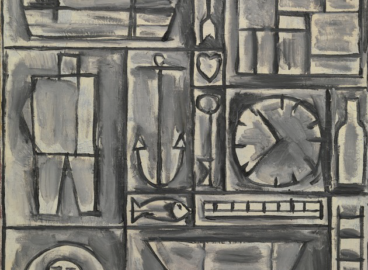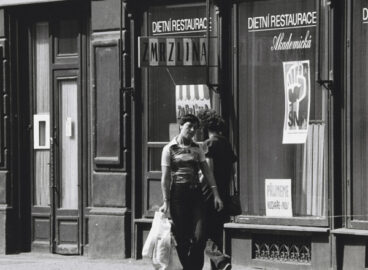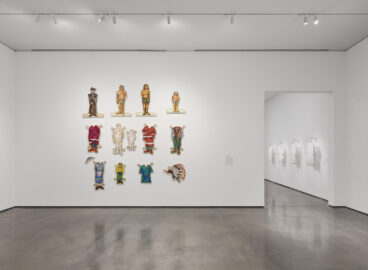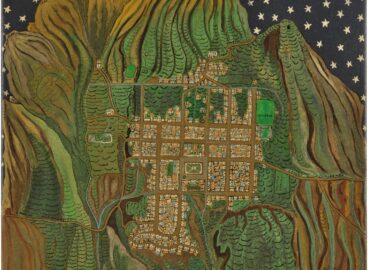In this interview, recorded a few months before Davidovich’s passing, curator Ana Janevski talks with the Argentine-American artist about his career, his early days in New York City and Cleveland, and his work Tape Wall Project (1970/1988), recently acquired by MoMA.
This is the first of two parts. Read the second part here.
ANA JANEVSKI: Jaime, one of your works, Cincinnati Tape Piece (1972), was part of the MoMA collection since some years ago. Recently, Tape Wall Project (1970/1988) was also acquired and is now part of the Media and Performance Art collection. Tell us a little bit about it and also about your practice, your arrival in New York City, and how your experience in the US has influenced your production.
JAIME DAVIDOVICH: I came to New York at the end of 1963. The first thing I did . . . the first thing I did in the city—I stayed with my sister in Queens—was to go to MoMA to see Guernica. At that time it was on extended loan to the Museum. And that was my first chance to see it. Before that, I had only seen it in reproductions. But seeing the real Guernica? That was a major, major event. After seeing the Guernica, I tried to contact some of the other Latin American artists living in the city. I didn’t speak much English. My English was very rudimentary, and so I wanted to meet other Latin American artists living in the US, to have some kind of contact with them. I wanted to see what they were doing. At that time in New York, there was an American woman, a critic and art historian named Jacqueline Barnitz who was very interested in Latin American art. Later on, she went to Texas University in Austin, and became the head of the Latin American art department there. She wrote the seminal textbook on twentieth-century Latin American art and has organized many exhibitions of Latin American art. But back then, once a week, she would open the doors of her very small studio apartment in the Upper West Side and host a sort of salon that was attended by every Latin American artist in New York City. You could go there, talk, have a glass of wine . . . new people would introduce themselves, and you would make connections and share ideas. And that was important for Latin American artists, because at the time we had no idea about how the New York art scene worked. We were very familiar with France, with Paris. Paris was the ideal place for the majority of Argentine artists. They would go to Paris to study at the André Lhote Academy. That was considered the place.


AJ: And so you were supposed to go to Paris?
JD: Yes, I was supposed to go to Paris. But instead of going to the André Lhote studio, I was planning to go to the studio of a new artist, a young artist named Pierre Soulages. He was one of the most prominent contemporary artists after the war. I had been corresponding with him and he had invited me to come and work there in his studio. But things didn’t work out for political reasons, and so I pursued a grant to come to New York instead. But then I was not at all prepared for the environment in New York.
AJ: Who else was at the salon?
JD: In terms of artists, the first person I met was an Argentine artist from Córdoba: Marcelo Bonevardi. Other artists there were Jose Antonio Fernández-Muro, Sara Grillo, Fernando Botero, Omar Rayo, Carlos Mérida, Fernando de Szyszlo, and Kazuya Sakai. But as a group, we didn’t have much in common with each other.
AJ: Apart from being Latin American.
JD: Yeah, our origins were Latin American. But I was not interested in Latin American art. I was more interested in Duchamp; I was more interested in the Dada artists; I was more interested in Picabia; I was more interested in Morandi; I was more interested in the things that artists were doing in Europe, in Group Zero—or in the things that artists had started doing in Japan, in the Gutai group. So I had another focus, another view. I didn’t have anything in common with these other Latin American artists. So anyway, I went to Jaqueline’s a couple of times but then stopped going. Luckily, I was able to get a job in Greenwich Village, in a publishing company that was dedicated to the distribution and promotion of Latin American art and literature—of anything made in Latin America. This was 1964. President Kennedy had created this organization called the Alliance for Progress, which promoted greater contact with the Latin American countries, and sponsored all kinds of exchange programs. One of the things they did was to collect all the books written by Latin American writers and published in Latin America. They had representatives in every country in Latin America, who would buy every single book written by a Latin American writer and published in Latin America.
AJ: That’s very ambitious.
JD: They would buy a few copies and send them to this place, to this publishing company called Hafner. Then, Hafner would distribute the books to major US institutions like the Library of Congress, the New York Public Library, Harvard University, the University of Texas. There were many universities and institutions that were part of this program, and I was hired by Hafner to be the archivist and cataloger of all the Latin American books. Hafner was located on 10th Street and Broadway, which also happened to be a very important area for American art. The 10th Street artists were the pioneers—before SoHo. And they had opened cooperative spaces called the 10th Street galleries, where they showed people like Mark di Suvero and the second–generation Abstract Expressionists—artists like Philip Guston. Also around there… Rothko had his studio in the Bowery, de Kooning had his studio on 11th Street. They would all go to the famous Cedar Tavern on University Place and spend time with people like Allen Ginsberg, Jack Kerouac, the Beat Generation. The 10th Street galleries were alternative galleries. They were not like the bigger commercial galleries in New York at that time. The center of that gallery world was the Upper East Side, from 57th Street to 77th Street. On 57th Street, you had the Pierre Matisse Gallery and the Kootz Gallery, which represented Picasso. And then you had the Martha Jackson Gallery on 68th Street, which represented foreign artists like Fontana, Tàpies, and Goldberg. And at the end was 77th Street was where the Leo Castelli Gallery was located.


Then, on Third Avenue and 10th Street, there were the alternative galleries, the alternative spaces. You know, the very raw spaces, where the walls were unfinished, and the exhibitions were very, very . . . unpolished. I was working one block from there, and I would go to those galleries at lunchtime and think, “Hey, this is the place that I have more things in common with, that I’m more interested in.” And so I started going to those 10th Street–Third Avenue galleries more regularly. And then a few years later, a gallery opened on LaGuardia Place and Bleecker, which is just a few blocks from 10th Street and Third. And this gallery was the Park Place Gallery. Later, galleries slowly started moving to the Bowery, into SoHo, and I got more involved with that scene. Basically, I lost contact with the whole Latin American group. They were living in another area, and had different interests. There were very few Latin American artists who shared my interests—there was Juan Downey, who came to New York in 1970, and Rafael Ferrer, who was friends with Robert Morris and Richard Serra . . . Marisol, another Latin American artist, had her studio on 10th Street and Broadway. She was doing Pop art and was part of the Castelli group. There were very, very, very, very few Latin American artists. And then I got more involved in the neighborhood. And in the early seventies, I became part of the SoHo scene.
AJ: And what was your practice during that period?
JD: I was interested in what I was doing when I was in Argentina, in the last pieces that I had done there: large paintings of segments of a landscape with no beginning and no end. I would take one wall in a gallery and I would do a huge painting that would show the landscape—like a night landscape, but with only one horizon. Later I did another series of paintings that were all white—of the horizon line during the day. I did those works on burlap, or on Masonite. And I showed them in several places. I was a member of a group of abstract artists. I was friendly with Greco, who was one of the few artists to return to Argentina in the early sixties. He had ideas about this German style of abstract art called tachisme, which corresponded to late Abstract Expressionism in America. And also we were in touch with some of the new Spanish artists like Canogar and Tàpies. I had been doing monochromatic work, and I continued doing that when I moved to New York. I would unroll the canvas and paint these infinite landscapes, and then I would take the canvas, without stretchers, and hang it on the wall. If somebody came, I would just hang it on the wall. I used pushpins or little nails for hanging. And then, around 1965, I decided that I didn’t like the way the pushpins looked and so I started using tape. That is when I started the tape projects. The tape became part of the composition of the work, which I started showing privately—not through a gallery or an institution, just to friends.
In 1970 I got a part-time job in Cleveland, Ohio. There, I discovered this new technology called videotape. And videotape was not available. Well, except for the Portapak, which became available in 1965—but it was only black-and-white, and it lasted only twenty minutes. The television studios, however, had very sophisticated equipment. And at the time, I was able to get to a hospital in Cleveland that had state-of-the-art equipment with color cameras and tapes that are not half inch, like they are in the Portapak, but one inch. I was able to start working there on videotapes and began using adhesive tape. In those works, like in my paintings, there was no starting point, no ending point; they would just continue and continue… This work is now at MoMA: a tape project that includes videotape and adhesive tape. When I started doing this work, I started getting attention.
AJ: Was your first tape work an installation? The work that we have at MoMA is from 1972.
JD: Yes.

AJ: So you spontaneously had this idea of taping half of the wall and then, on the other half of the wall, installing a screen that would show you doing the taping?
JD: Yes. That’s correct. In 1972 a lot of things changed. It was then that I had the first invitation to do a video-and-tape installation at the Akron Art Museum.
AJ: But didn’t you do another tape installation in Cleveland before that, in the staircase?
JD: Well, yes, I did a lot of tape installations. I started doing these in 1969. I worked a lot in galleries, in museums, on the street… But the inclusion of video was in 1970, and the first exhibition of video and tape, of adhesive tape, was in a museum in 1972.
AJ: But you did the first one, the one that is part of MoMA’s collection, in 1972, no?
JD: So here’s the thing. Historically, this is the context: How can you do that kind of work in what is basically a small town, outside the centers of the avant-garde? Because in Cleveland, I was not living off my art… But when I got there, two things happened: First is that I got in contact with a hospital that had state-of-the-art equipment that I was able to use. Then second is that Nina Castelli, who is Leo Castelli and Ileana Sonnabend’s daughter, opened a very small gallery called the New Gallery in an old house in Cleveland. It became a focal point for art activity. All of Nina’s artist would come to Cleveland: Oldenburg, Jasper Johns, Richard Serra… and then she would select some local artist to “merge” with the New Yorkers. So that’s how I became a member of the gallery.
AJ: How were you financing your stay in Cleveland, and how long were you there for?
JD: It was maybe a year and a half and I was working in graphic design. And when I was there, doing those tape shows, I got a lot of publicity. I was doing things on the street, in staircases, on big walls .. Somebody came from Artforum… things were very good. Then, a curator from the Whitney Museum came to Cleveland, and she selected me to be part of Whitney Biennial. At that point I said to myself, “I have to go back to New York. I have no choice.” And so I returned to New York. I think it was 1973. I got a few grants, which helped me buy my video equipment, and I became a very active member of the video art community in SoHo.
AJ: Did you have a show at Nina’s Gallery?
JD: Yes, I had several shows at the New Gallery. Nina also introduced me to some people. It was an incredible experience. In hindsight, I think about the pieces that she had and couldn’t sell… Oh my God! It was like a thousand dollars for a Richard Serra or a Joseph Kosuth. Original pieces… And then Nina, too, came back to New York and she created this organization that is still very active: Independent Curators International.
AJ: In Cleveland, then, was where you first used tape . . .
JD: Yes, yes, Cleveland was first. And then I started doing [it] in New York, where I was also doing drawing and collage. In New York, I had a bigger studio–three thousand square feet—and I was working full-time on my art. That was a big, big difference. It was the beginning of the time when museums and some alternative spaces became interested in video. It was the time when MoMA started their video program, when the Whitney started the New American Filmmakers, when the Kitchen opened, when Anthology Film Archives opened. It was the early seventies.
This is the first of two parts. Read the second part here.






